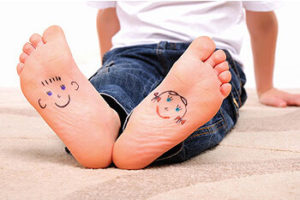Pediatric Foot Care
 You’re concerned about your child’s teeth, skin, and other body parts. You teach your child to wash, clean, and groom themselves, but what about their developing feet that would bear the entire weight of the body for the rest of their lives?
You’re concerned about your child’s teeth, skin, and other body parts. You teach your child to wash, clean, and groom themselves, but what about their developing feet that would bear the entire weight of the body for the rest of their lives?
Many adult foot problems begin in infancy and are present from birth. Daily professional treatment and proper foot care will help to prevent these issues later in life. A child with problematic feet walks poorly and has poor balance in general.
Your Child’s Feet
The human foot has 26 bones and is laced with ligaments, muscles, blood vessels, and nerves, making it one of the most complex parts of the body. Due to the delicate and pliable nature of young children’s feet, abnormal pressure may easily cause deformities.
During the first year of life, a child’s feet develop steadily, reaching about half the size of an adult’s foot. This is why foot doctors consider the first year to be the most important in the development of the feet.
Here are several pointers to help you ensure that this development goes smoothly:
- Take a close look at your baby’s feet. If you find something that does not seem to be natural, seek professional help right away. Deformities will not go away on their own.
- Cover the baby’s feet loosely. Tight covers can limit movement and can stifle normal development.
- Make it possible for the feet to be exercised. The baby will kick and perform other similar movements when lying uncovered, which helps to prepare the feet for weight-bearing.
Walking For The First Time
Forcing a kid to walk is not a good idea. The child can walk when he or she is physically and emotionally ready. Comparisons to other children are deceptive since the age at which a child can walk independently varies from 10 to 18 months. Babies’ feet should be covered with lightweight, flexible footwear when they are on hard surfaces.
There’s no need to spend a lot of money on shoes. The shoes can just cover the foot and do not need to protect the arch or ankle in any way. These structures can grow naturally when the child walks if the feet are regular. A flexible sole is preferable to a rigid sole. Ankle-supporting high-top shoes are not recommended.
Growing Up
As a child’s feet develop, it may be appropriate to switch shoe and sock sizes every few months to accommodate their development. Foot disorders are often caused by accident, deformity, disease, or genetic causes, but wearing the wrong shoes may aggravate preexisting conditions. It is never a good idea to pass down shoes or other types of footwear.
Because of muscle issues, young children’s feet are often unstable, making walking painful or unpleasant. Our foot and ankle specialist can detect an underlying defect or condition that requires treatment during a thorough examination.
Remember that a child’s lack of complaint is not a reliable indicator. Growing feet’s bones are so malleable that they can be bent and distorted without the child being aware of it.
Sporting Events
Hundreds of millions of children in the United States engage in team and individual sports. Sports that require a lot of running and turning, as well as sports that include touch, are of particular concern. Ankle protective taping is often needed to avoid sprains or fractures. If their children participate in physical sports, parents should talk to our foot and ankle doctor about these issues.
If you are concerned about your child’s feet, give us a call today (832) 415-1790 or book an appointment online.

